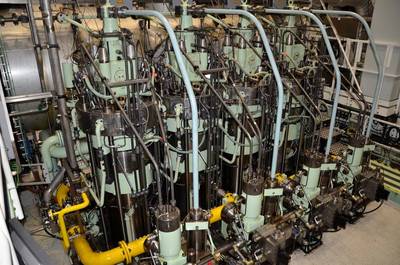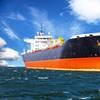World-first ME-GA Engine Demonstrated in Copenhagen
MAN Energy Solutions has has demonstrated its latest low-speed, dual-fuel engine—an MAN B&W ME-GA type designed for liquefied natural gas (LNG)/fuel-oil running—at a ceremony live-streamed from its Copenhagen Research Center on Thursday. The new engine is an Otto-cycle variant of the company’s ME-GI engine.
As its pre-mixed combustion results in low NOx emissions, the ME-GA engine is inherently Tier II and Tier III compliant in gas-operation mode. To fully utilize its dual-fuel potential in Tier III areas, the engine is being offered with exhaust gas recirculation (EGR).
Wayne Jones OBE, Chief Sales Officer, MAN Energy Solutions, participated in the event, which was hosted by Bjarne Foldager, Senior Vice President and Head of Two-Stroke Business, and Thomas S. Hansen, Head of Two-Stroke Promotion and Customer Support.
Jones said, “Our development of new technologies is directly influenced by the close relationships we have with our customers. We initiated this ME-GA project in late 2017 when we recognized a strong market desire for a lower-cost alternative to the ME-GI engine, driven primarily by the LNG carrier market. Crucially, this new supplement to our dual-fuel portfolio continues our mission to decarbonize shipping and further the maritime energy transition to sustainable fuels.”
MAN Energy Solutions said it aims to start testing the first, commercial ME-GA design by the end of this year, with the first engine delivery following in early 2022.
Foldager said, “It’s taken a team of 150 colleagues, and hundreds of tests and operational hours, to get the engine to this important stage. In doing so, we have drawn on the invaluable experience gained from developing our successful ME-GI concept. Similarly, our proprietary EGR system also plays an important role in the ME-GA set-up. Not only does it deliver NOx-compliance, it also helps maintain control of the ignition process and reduces fuel consumption by 3 and 5% in gas and fuel-oil modes, respectively.”
He added, “This is just the latest milestone in the dual-fuel strategy we have followed over the past decade, and further confirms our leadership in this critical marine segment. Our dual-fuel engines continue to act as standard bearers for environmentally friendly, reliable propulsion-technology with their seamless switching between fuels. Ultimately, we expect the ME-GA to become standard among LNG carriers.”
MAN Energy Solutions reports that its portfolio of two-stroke, dual-fuel engines has accumulated more than 1.6 million operating hours from the 155 engines (6.3 GW) currently in service—all running on clean fuels such as LNG, liquefied petroleum gas (LPG), ethane and methanol. With fuel prices and availability currently in flux, MAN Energy Solutions said it expects the option of retrofitting to dual-fuel engines to increasingly become a necessity.
ME-GA
The high-efficiency MAN B&W ME-GA engine delivers a low capex solution aimed at certain vessel types and applications, such as LNG carriers, that are able to use ‘boil-off’ gas as a source of fuel, according to MAN, adding it will also be of appeal to smaller vessels where low capital outlay is a priority.
Based on the MAN B&W dual-fuel design with minimal installation requirements, the MAN B&W ME-GA uses an efficient ignition concept and unique gas-admission system that delivers safe and reliable operation.
The ME-GA furthermore features minimal operational costs, simple supply and purging concepts, and low maintenance costs for its fuel-gas supply system, the manufacturer said. With Tier III compliance in gas mode, the engine meets all current and upcoming NOx emission regulations with the addition of EGR.
EGR
In November 2020, MAN Energy Solutions announced it would offer its proprietary EGR system as an emissions solution for the ME-GA. EGR is a NOx-emissions-reduction technique that ensures IMO Tier III-compliance in diesel mode for the ME-GA.
The company reports that EGR will enable the ME-GA to reduce specific gas consumption by approximately 3%, and specific fuel-oil consumption by 5%. It will also significantly reduce methane slip by 30 to 50%, and improve the stability of the Otto-cycle combustion process. EGR will enable the ME-GA to meet Tier III requirements in both fuel oil and gas modes without additional aftertreatment.
The ME-GA EGR solution is a high-pressure system, which can be integrated into existing engine-room designs, and the EGR unit itself does not change the engine footprint. Its design-similarity to that of ME-C engines’ EGR systems will lower its price point, since the supply chain and components are already matured.
The volume requirements of the ME-GA EGR system are also significantly lower with, for example, less pipework required than for low-pressure EGR solutions.














